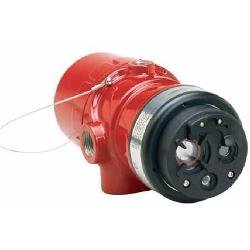- 50% less
X5200A4N13W1 Det-Tronics UVIR Flame Detector
Detects hydrocarbon fires by correlating signals from both an ultraviolet (UV) and infrared (IR) sensor. Sophisticated algorithms enable rejection of UV radiation sources such as arc welding and lightning. Available with a HART option and is certified SIL 2 capable. Often used for applications such as munitions and aerosol fill.
- Shipping info
We deliver worldwide
- Payment methods
- Return Policy
We accept returns
- Customer Reviews
Check out our customer Reviews
Det-Tronics is the global leader in fire- and gas-safety systems, providing premium flame- and gas-detection and hazard-mitigation systems for high-risk processes and industrial operations. The company designs, builds, tests and commissions SIL 2 Capable flame- and gas-safety products that range from conventional panels to fault-tolerant, addressable systems that are globally certified. The corporate headquarters of Det-Tronics is located in Minneapolis, MN, USA, where flame, gas, mitigation products, and systems are designed, manufactured, and tested for installations around the world. The model is X5200A Det-Tronics UVIR Flame Detector (008516-001). Approved to FM 3260 (2000), the X5200A meets the most stringent requirements worldwide with advanced detection capabilities and immunity to extraneous sources, combined with a superior mechanical design. The mounting arrangement allows the UV and IR sensors to monitor the same hazardous location with a 90-degree cone of vision. When both sensors simultaneously detect the presence of a flame, an alarm signal is generated. The detector has Division and Zone explosion-proof ratings and is suitable for use in indoor and outdoor applications. The product is featured by automatic, manual or magnetic optical integrity testing. Class A wiring per NFPA-72. 3-year warranty on sensor and electronics. FM, CSA, ATEX, CE, VDS, CNBOP Approvals. EN54-10 Certified. Output Options include: Relays, 4-20 mA, RS-485, EQP Addressable, and Pulse Output. When pulse output is specified, the ultraviolet infrared (UVIR) flame detector is for use in controller based systems. The pulse-output model can replace existing Det-Tronics controller based flame detection systems that generate a pulse output. Compatible controllers include: Series R7404, 7494, and R7495 Controllers. Det-Tronics is a part of UTC Climate, Controls & Security, a unit of United Technologies Corp. a leading provider to the aerospace and building systems industries worldwide. To offer products that meet our exact requirements, we manufacture (at a component level) many of the flame and gas detectors used in our systems. This characteristic makes us unique among many of the safety system manufacturers.
The X5200A UV Flame Detectors meet the most stringent requirements worldwide with advanced detection capabilities and immunity to extraneous sources, combined with a superior mechanical design. The mounting arrangement allows the UV and IR sensors to monitor the same hazardous location with a 90 degree cone of vision. When both sensors simultaneously detect the presence of a flame, an alarm signal is generated. The detectors have Division and Zone explosion-proof ratings and is suitable for use in indoor and outdoor applications.
The standard output configuration includes fire, fault and auxiliary relays. Output options include:
– 0 to 20 mA output (in addition to the three relays)
– Pulse output for compatibility with existing Detector
Electronics Corporation (Det-Tronics) controller
based systems (with fire and fault relays)
– Eagle Quantum Premier® (EQP) compatible model
(no analog or relay outputs)
– HART communication
A tri-color LED on the detector faceplate indicates normal condition and notifies personnel of fire alarm or
fault conditions. Microprocessor controlled heated optics increase resistance to moisture and ice. The detector housing is available in copper-free aluminum or stainless steel, with Type 4X and IP66/IP67 rating.
OUTPUTS
Relays
The standard detector is furnished with fire, fault, and auxiliary relays. All three relays are rated 5 amperes at
30 Vdc. The Fire Alarm relay has redundant terminals and normally open / normally closed contacts, normally
de-energized operation, and latching or non-latching operation. The Fault relay has redundant terminals and normally open contacts, normally energized operation, and latching or non-latching operation. The Auxiliary relay has normally open / normally closed contacts, and is configurable for energized or de-energized operation, and latching or non-latching operation.
0 to 20mA Output
A 0 to 20 mA output is available as an option (in addition to the three relays). This option provides a 0–20 mA dc
current output for transmitting detector status information to other devices. The circuit can be wired in either an
isolated or non-isolated configuration and can drive a maximum loop resistance of 500 ohms from 18 to 19.9 Vdc and 600 ohms from 20 to 30 Vdc. Table 1 indicates the detector status conditions represented by the various current levels. The output is calibrated at the factory, with no need for field calibration. A model with relays and 0–20 mA with HART is also available. Refer to Addendum number 95-8636 for complete details.
NOTE
The output of the 0–20 mA current loop is not monitored by the fault detection circuitry of the
detector. Therefore, an open circuit on the loop will not cause the fault relay to change state or the
detector status LED to indicate a fault. The status of the LED always follows the status of the relays.
An alarm condition will normally over-ride a fault condition, unless the nature of the fault condition impairs the ability of the detector to generate or maintain an alarm output, i.e., loss of operating power.
Table 1—Detector Status Conditions Indicated by Current Level
| Current Level (±0.3 mA) | Detector Status |
| 0 mA | Power Fault |
| 1 mA | General Fault |
| 2 mA | oi Fault |
| 4 mA | Normal Operation |
| 8 mA | IR Pre-Alarm only |
| 12 mA | UV Alarm only |
| 14 mA | IR Alarm only |
| 16 mA | Pre-Alarm |
| 20 mA | Fire-Alarm |
LON/SLC Output
The EQP model is designed for use exclusively with the Det-Tronics Eagle Quantum Premier system. The
detector communicates with the system controller over a digital communication network or LON/SLC (Local
Operating Network / Signaling Line Circuit). The LON/SLC is a fault tolerant, two wire digital communication
network arranged in a loop configuration. Analog and relay outputs are not available on this model.
LED
A tri-color LED on the detector faceplate indicates normal condition and notifies personnel of fire alarm
or fault conditions. Table 2 indicates the condition of the LED for each status.
| Detector Status | LED Indicator |
| Power On/Normal Auto oi (no fault or fire alarm) | |
| Power On/Normal Man oi | |
| Fault | |















